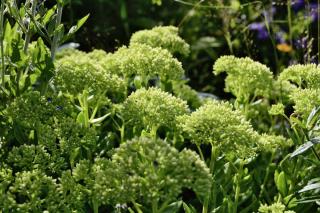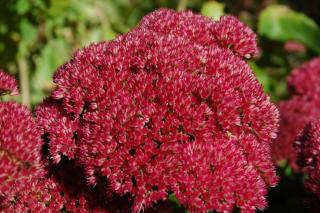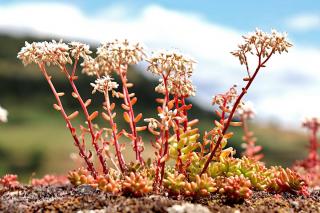

Stonecrop is a fascinating succulent plant that, once discovered, will always trigger wonder, curiosity… and lust for more and more of its surprising species!
Basic Stonecrop facts:
Botanical name – Sedum sp.
Common – stonecrop or sedum
Family – Crassulaceae
Type – perennial
Bearing – variable, depends which species (creeping to upright)
Height – 2 to 20 inches (5 to 50 cm) depending on the species
Planting density – 3 to 4 plants per square yard or meter for larger species, 8 to 10 for the smaller ones
Exposure: full sun – Soil: any, but draining – Flowering: May to October (species)
Stonecrop is a fabulous plant, for many reasons: it’s easy to grow, very resilient and there is an amazing diversity among all the species. Whatever you need to cover and wherever you want flowers, there is always at least one Sedum that will match your needs: rock garden, walls, in flower beds…


After the blooming is over, all you need to do is cut flower scapes off.
Note that even though stonecrop resists drought very well, you do have to be careful during the first summer after planting.
don’t cut your taller Sedums too early (S. spectabile, S. spurium). Indeed, winter frosts will decorate them with beautiful crystals of light! Wait for spring to cut them short.
To multiply your stonecrop, all you need to do is separate it:
For species that have large leaves, such as Sedum spectabile, you can also try to start cuttings from individual leaves. Pick a few leaves from the stalk, let them dry off for 2 days (48 hours), and stick the lower third in a mix of sand and potting mix. Make sure this stays moist but not soggy, and after a while you’ll notice a miniature plant starting off from the base of the leaf.

The Sedum family is vast – there are so many different species that you can flower your entire garden with just this perennial and still find that space is lacking for this or that species…
However, if you like to have very different flowers, these make for beautiful pairs:
Sedum spectabile: the tallest stonecrop species. Tall upright mound and thick stems with blue-green leaves. Pink flowers. Sedum spectabile blooms in August and September.
Sedum spathulifolium: the compact blue-to-purple leafage really makes its yellow stand out.
Sedum sieboldii: grows into a small round pillow with round blue leaves. Autumn-bloomer.
Sedum acre: will form a never-seen-before yellow pillow in Summer, it will be like having a little Sun in your garden.
Sedum reflexum: thin leaves take on a beautiful green-blue hue (also called Sedum rupestre).
Don’t cut the stems of your taller stonecrop species too early (S. spectabile, S. spurium). In Winter, Jack Frost will have fun encasing them in ice and snow-like crystals, making your garden truly fairy-like! Wait until Spring to cut the plants back.